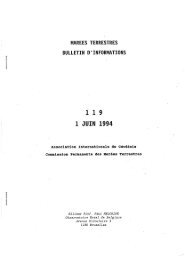marees terrestres bulletin d'informations - Université de la Polynésie ...
marees terrestres bulletin d'informations - Université de la Polynésie ...
marees terrestres bulletin d'informations - Université de la Polynésie ...
Create successful ePaper yourself
Turn your PDF publications into a flip-book with our unique Google optimized e-Paper software.
exp<strong>la</strong>in such an effect only by the insufficient resolution of the ocean ti<strong>de</strong>s mo<strong>de</strong>l in the Red<br />
Sea, as the ocean loading values associated with that bias represent twice the amplitu<strong>de</strong> of the<br />
computed ocean loading for the diurnal waves and 50% of it for M2. One can suspect perhaps<br />
a change of the calibration factor of the instrument.<br />
Table 2: Ocean ti<strong>de</strong> loading computation at Hrghada station.<br />
Wave Amplitu<strong>de</strong><br />
nm / s²<br />
Phase<br />
shift (<strong>de</strong>gree)<br />
Amplitu<strong>de</strong> Factor<br />
corrected<br />
Phase Shift<br />
corrected<br />
Q1 0.7 -179.1 1.1109 -0.244<br />
O1 1.9 176.9 1.1364 0.037<br />
P1 0.8 145.2 1.1377 -0.042<br />
K1 2.8 147.9 1.1188 -0.261<br />
N2 4.4 -96.6 1.1528 1.905<br />
M2 15.2 -76.2 1.1431 1.254<br />
S2 4.4 -47.9 1.1278 0.626<br />
Table 3: Discrepancies between theoretical and observed tidal parameters at Hurghada<br />
station.<br />
Wave<br />
Amplitu<strong>de</strong><br />
Theoretical<br />
Amp. Factor<br />
Theoretical<br />
Residual<br />
Vector<br />
nm / s²<br />
Phase of<br />
residual<br />
vector<br />
Q1 48.4448 1.1561 4.78 142.48<br />
O1 253.0250 1.1559 5.01 177.89<br />
P1 117.7320 1.1504 1.51 176.71<br />
K1 355.8535 1.1349 5.96 162.34<br />
N2 113.4428 1.1596 4.44 101.74<br />
M2 592.5144 1.1596 18.02 124.68<br />
S2 275.6689 1.1596 9.53 159.04<br />
9. Gravity Residuals and Conclusions<br />
The tidal gravity residuals are given in Fig. 6. The residuals have a general range of about<br />
± 10 nm/s². No significant anomalies can be recognized in the residuals. The amplitu<strong>de</strong><br />
spectrum of residual gravity is very important to prove if the tidal waves are completely<br />
approximated or not. It can be noticed that tidal signals are still contained in the gravity<br />
residuals. The ANALYZE program allows the computations of the Fourier amplitu<strong>de</strong><br />
spectrum of the residuals (Fig. 7). It shows a noise level in the diurnal band of up to 5.5 nm/s²<br />
and in the semidiurnal band of 6 nm/s². Also at higher frequencies a noise level of 4.7 nm/s 2<br />
can be recognized. The peaks correspond to shallow water components probably caused by<br />
ocean ti<strong>de</strong> loading in the Red Sea. The significant energy in the residual spectrum may be due<br />
to the timing problem of the quartz clock, and air pressure variation, which was not<br />
consi<strong>de</strong>red during registration and analysis.<br />
11853



